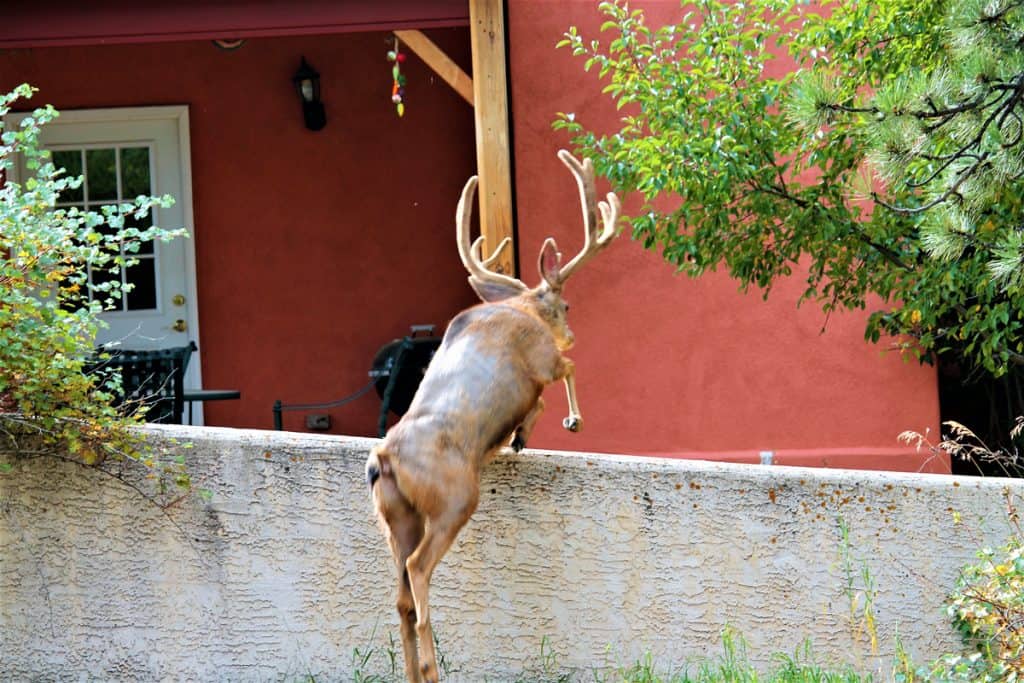Daylilies are a colorful, beautiful addition to any garden or flowerbed. They are vibrant, typically easy to grow, and require little work to thrive. Understanding where and how to plant them increases their chance for success in your garden. But, it would be best if you also considered whether deer eat daylilies? We've researched the answer to this question to help ensure that your daylilies last as long as possible.
Deer love to eat daylilies, and if you leave these plants unprotected, they will become a tasty meal for those unwanted intruders. So, it's critical to protect your daylilies from deer. You can employ one or more of these strategies to protect your plants:
- Use deer repellent to protect your daylilies.
- Surround your daylilies with flowers and shrubs that deer do not like to eat.
- Protect your daylilies with a fence.
- Use loud noises, water, and lights to frighten deer.
Understanding that your daylilies are at risk of being a deer's meal is essential. Knowing exactly how to protect them is even more critical. We invite you to keep reading to learn more about each of the strategies we have listed above. You can then effectively employ these in your garden to protect your daylilies.
![A close up photo of daylily on a sunny day, Do Deer Eat Daylilies? [And How To Prevent That]](https://gardentabs.com/wp-content/uploads/2020/09/Do-Deer-Eat-Daylilies-And-How-To-Prevent-That-683x1024.jpg)
Deer Repellent
Daylilies tolerate most climates well, require adequate sun, and are planted throughout the growing season. Once you have grown them, you've got to make sure to protect daylilies from deer. Deer repellent can be an excellent way to protect your daylilies.

There are two main types of deer repellent: spray and granules. You can apply spray repellent to your daylilies as soon as they are planted. While most kinds of spray repellents are waterproof, they wear off after a few weeks or months. They'll need to be reapplied with some regular frequency to maintain their effectiveness. Similarly, it's critical to follow the specific instructions of any deer spray repellent that you buy.
You can buy this deer repellent spray on Amazon.
Spray repellant is not the only type of effective repellent. Granules are also a great choice. You simply spread the granules around the base of the flowers and on them, too. If spread immediately preceding a heavy rain, you'll likely need to reapply them sooner than you anticipated.
This granular deer repellent can be purchased on Amazon.
Whether you choose to use a spray repellent or a granular one, it's important to know that neither is a "one and done" solution. Reapply deer repellants often to be as effective as possible.
Flowers That Deer Do Not Like
Another way to protect your daylilies from deer is to surround them with plants that deer do not like to eat. These types of flowers, shrubs, and trees can effectively deter the animals from coming near your daylilies in the first place. Forsythia and lilacs, for example, are two types of shrubs that deer avoid. Ferns, marigolds, peonies, and poppies are just some of the kinds of flowers that you can plant in your garden to create a natural barrier from deer.
By incorporating variety into your garden, you can not only protect your daylilies, but you can also create a more visually appealing and stunning area. Choosing the right types of bushes and flowers to go with your daylilies make them less susceptible to deer while also enhancing your flower bed's overall appearance.

Install A Fence
Utilizing a fence is one of the best ways to protect your daylilies from deer. However, a fence is only useful when it is tall enough to keep deer out of your garden and away from your flowers. Deer, especially the adults, are fantastic jumpers. They can easily clear walls and fences that are too short. Therefore, be aware that you'll need to have a fence at least six feet tall to prevent deer from getting into your flowerbed.
Keep in mind that even though fences have a proven track record of success for deer prevention, they also prevent people from seeing all of your hard landscaping work. After all, a tall fence will make it all the more difficult for people walking or driving by to see the beautiful area that you have created; therefore, it isn't the best choice for clearly displaying your flowerbed.

Scare Them Away
Deer are timid and easily frightened. They have to be to survive. Taking advantage of that elevated level of fear is another way you can protect your daylilies from becoming their next snack or meal.
There are several methods you can use to frighten deer. Planting your daylilies near the house means that you or your pet are more likely to see the animals venture into your flowers. Yelling, banging on windows, or a barking dog is often enough to scare them away.
You can also use motion-detecting lights to scare the animals when they come in at night. Their movement triggers lights, which in turn scare them off.
There are also devices you can buy that combine motion detection with water. These devices are harmless but effective deterrents that prevent deer from foraging on your daylilies and other plants.
This motion-activated sprinkler is available for purchase on Amazon.
Whether you choose to plant your daylilies close to the house, rely on your pet, or use motion-detection technology, scaring deer away is another proven protection method.
Summary
Gardening is a great way to relieve stress, enhance your property, and spend time outside. Daylilies are gorgeous flowers that complement the rest of your garden. As we've seen, they make a very inviting meal for deer. They're not the only plants that attract deer, though. For more information about what types of flowers and plants attract deer, and how to protect them, take a look at some of our other posts:



